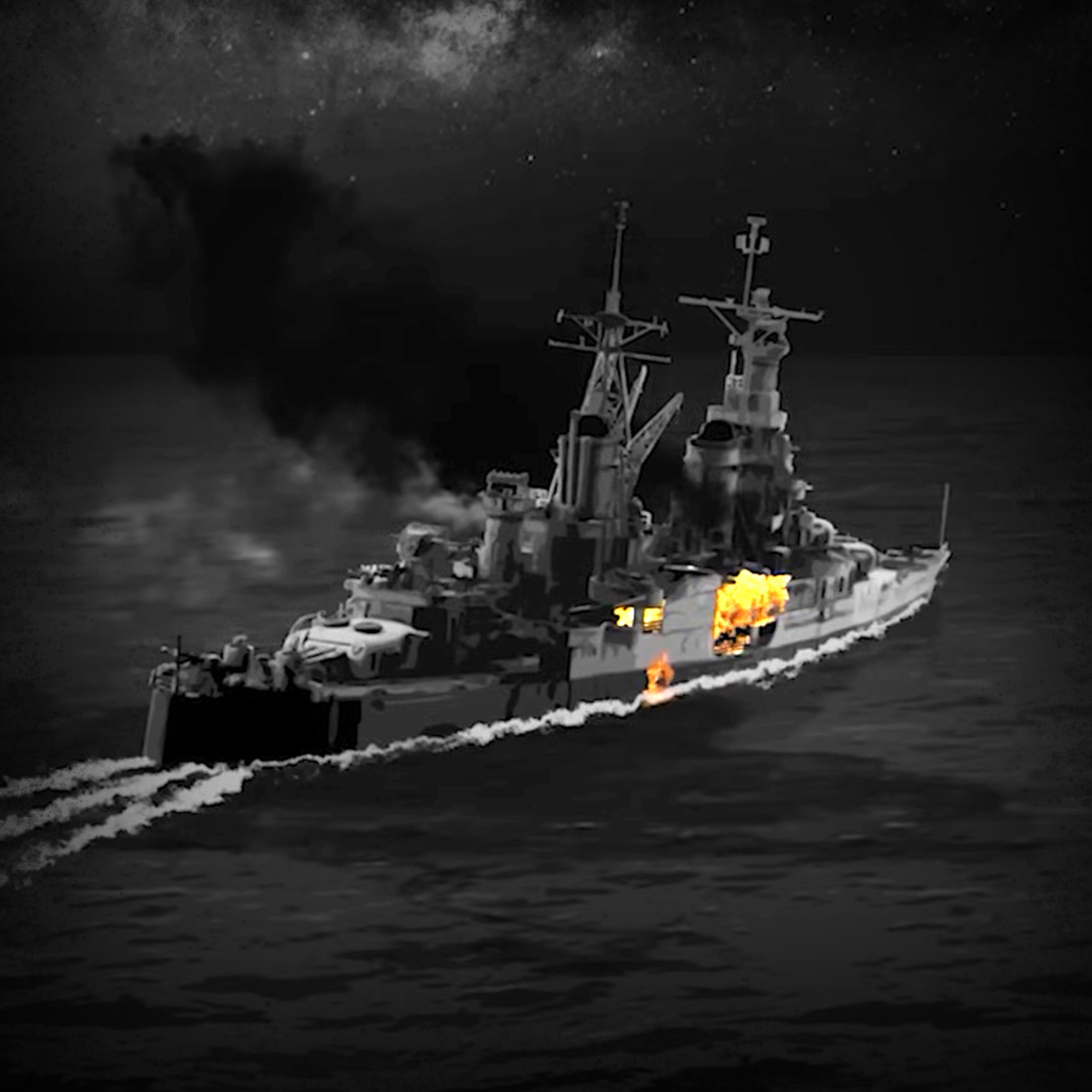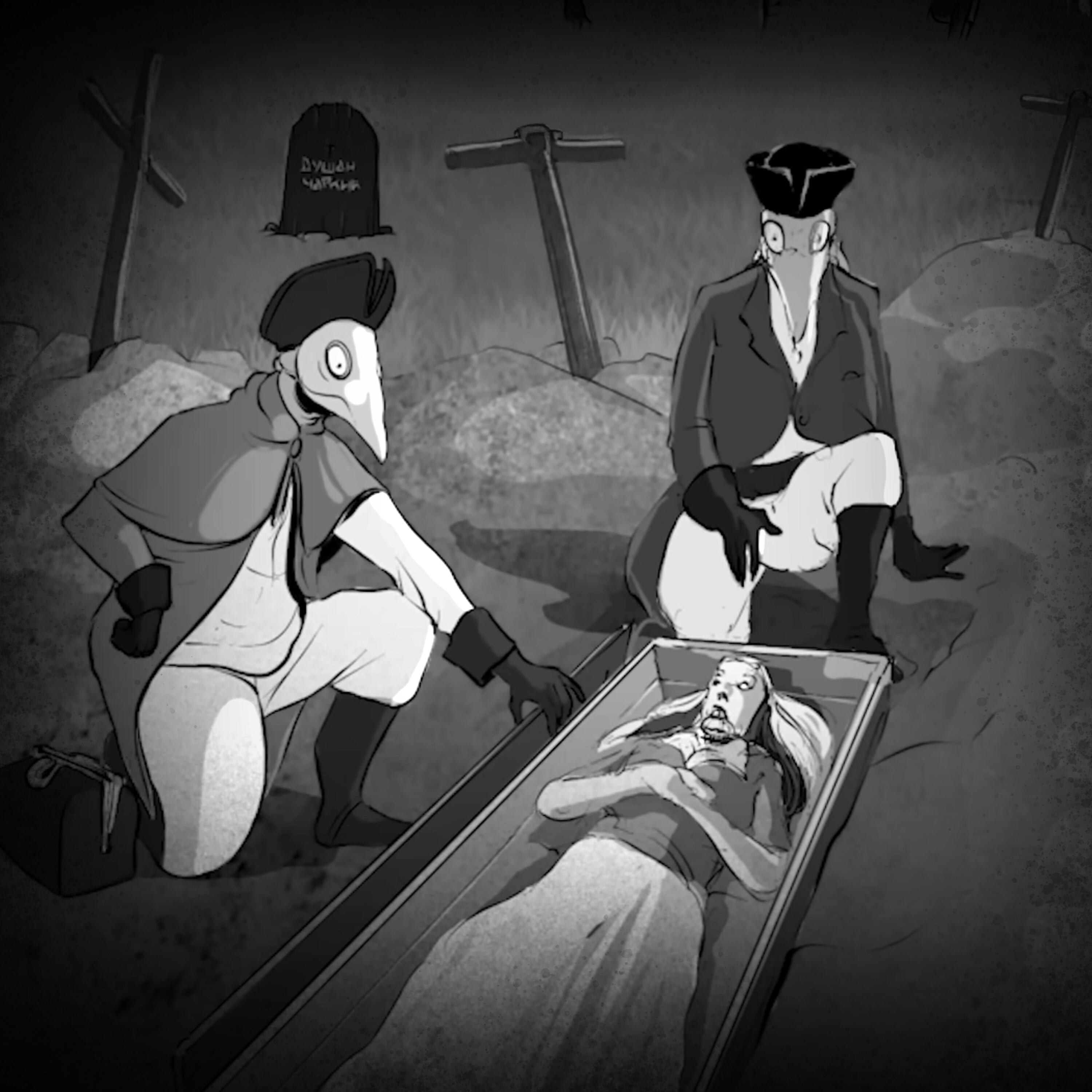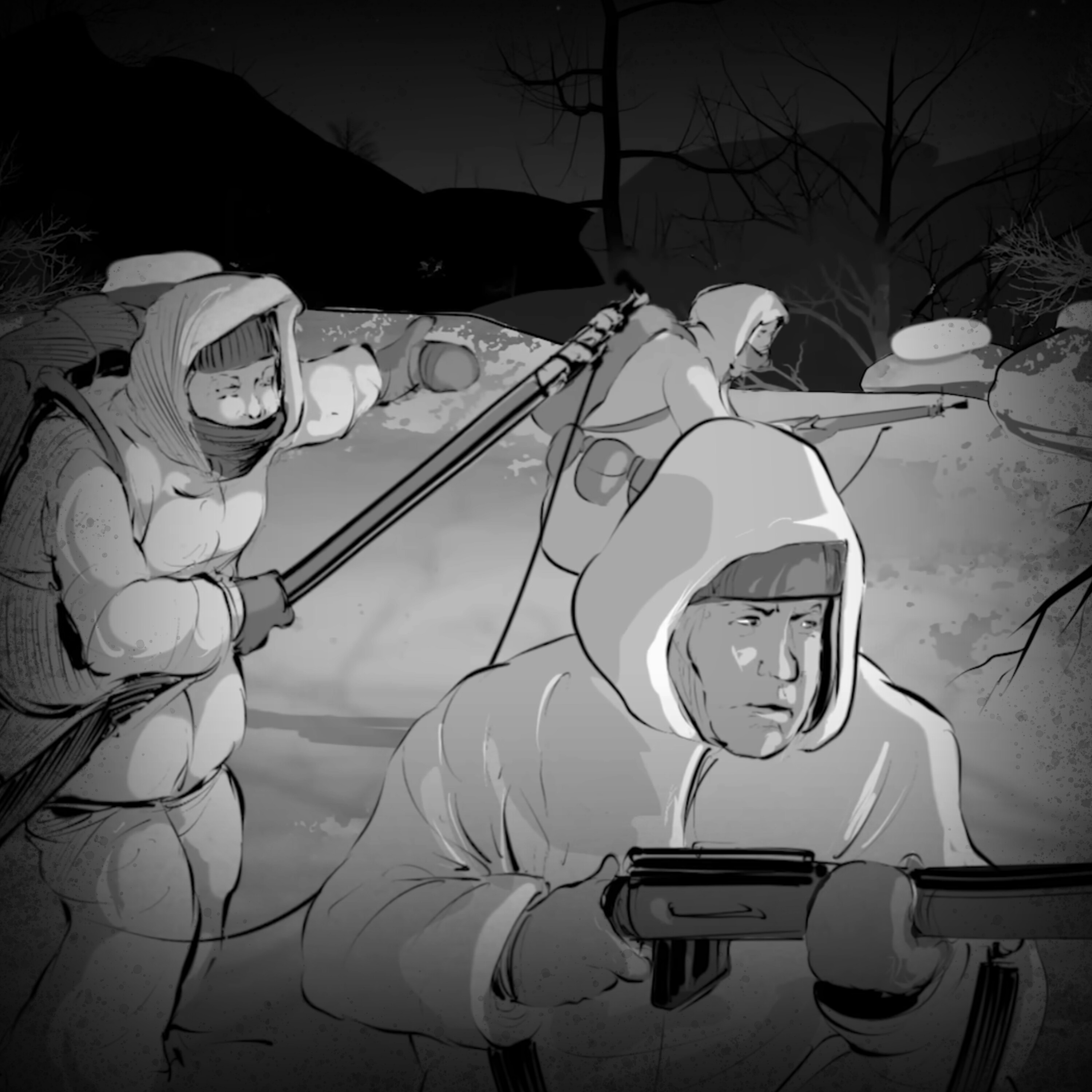A Fate Worse Than Death... Pt. 1
The USS Indianapolis, after delivering a key component of the atomic bomb, was sunk by a Japanese submarine, leaving hundreds of sailors stranded in shark-infested waters for five days.
See Privacy Policy at https://art19.com/privacy and California Privacy Notice at https://art19.com/privacy#do-not-sell-my-info.
Press play and read along
Transcript
Speaker 1 If you're drawn to stories like wartime stories, you'll enjoy exploring more from Balin Studios and Wondery, like my other podcast, Redacted Declassified Mysteries.
Speaker 1 Both shows are available early and ad-free on Wondery Plus. Start your free trial today.
Speaker 2
Your life isn't one size-fits-all. Every day brings something different.
Your style should too. At Maurices, we make it easy to show up feeling comfortable, confident, and completely you.
Speaker 2
Our over 800 stylists are here to help you look your best. From tried and true denim to head-turning looks, we've got styles that fit your life and your budget.
Fashion made for real-life moments.
Speaker 2 Maurice's.
Speaker 3
I've never felt like this before. It's like you just get me.
I feel like my true self with you. Does that sound crazy? And it doesn't hurt that you're gorgeous.
Speaker 3 Okay, that's it. I'm taking you home with me.
Speaker 3 I mean, you can't find shoes this good just anywhere. Find a shoe for every you from brands you love, like Birkenstock, Nike, Adidas, and more at your DSW store or dsw.com.
Speaker 3 Where is he?
Speaker 3 Send him out there! Over here!
Speaker 3 Just after midnight on the 30th of July, 1945, the USS Indianapolis was sunk by two torpedoes fired from a Japanese submarine. 1,196 souls were on board.
Speaker 3 Within 12 minutes, 300 of their number had perished before the massive ship disappeared beneath the surface. The remaining men, those who could swim anyway, made it out into the open water.
Speaker 3 For the next five days, burning under a merciless sun, slowly driven mad by thirst and starvation, the survivors huddling together in the water found themselves stranded, hundreds of miles from land, praying for rescue.
Speaker 3 But although the ship's radio man did manage to send out a distress call before abandoning the ship, it was ignored.
Speaker 3 No one believed the Indianapolis was sunk.
Speaker 3 No one would come looking for them.
Speaker 3 Nothing
Speaker 3 except the sharks.
Speaker 3 This is the story of the USS Indianapolis
Speaker 3 Blood in the Water.
Speaker 3 I'm Luke Lamana,
Speaker 3 and this is Wartime Stories.
Speaker 3 The story of the USS Indianapolis and its crew members goes well beyond the suffering of the men who were set against the odds of nature when their ship was lost at sea.
Speaker 3 Indeed, Before its tragic sinking, this Portland-class heavy cruiser played a pivotal role in the American war effort, engaging in 10 of the bloodiest battles in the Pacific Island Campaign against the Japanese.
Speaker 3 Following the attack on Pearl Harbor, she returned to the Hawaiian Islands before being assigned to serve as an escort ship for various convoys during the first half of 1942.
Speaker 3 By August, she was patrolling the freezing waters of the North Pacific near Alaska, supporting American units in the Aleutian Islands campaign, bombarding Japanese outposts, and disrupting the enemy's ocean supply routes.
Speaker 3 A year later, with Japanese forces finally withdrawing from the Aleutian Islands, the Indy was rerouted to the warmer waters of the South Pacific.
Speaker 3 Supportive American island campaigns continued, with the Indianapolis providing ship-to-shore artillery bombardment to soften the enemy defenses at Tarawa and Macon, the Marshall Islands, the Palau Islands, then to Saipan.
Speaker 3 Following the invasion of Saipan in the summer of 1944, Japanese forces responded by sending a powerful fleet to attack the American ships, resulting in the Battle of the Philippine Sea.
Speaker 3 Following a decisive victory in ship-to-ship combat, the Indy then moved to Iwo Jima before returning to the Mariana Islands to engage in the Battle of Tinian Island, then to Guam, and then to the invasion of Pelelu in the Palau Islands.
Speaker 3 Following repairs, she was sent off shore of mainland Japan, conducting a carrier attack on Tokyo, before rerouting back to Iwo Jima, where she acted as a shore bombardment ship for much of the battle.
Speaker 3 During this fight to take Iwo Jima as the command vessel, the Indianapolis remained closest to the island.
Speaker 3 Sailors on board watched the battle from a distance, some later stating they did not begrudge their enlistment in the Marines being denied, as they now watched the seawater turning red from the blood of the Marines landing on the shoreline.
Speaker 3 Some sailors even watched, through their binoculars, the raising of the flag on Mount Suribachi, understandably unaware of its significance at that time.
Speaker 3 Following Iwo Jima, the ship then moved on to Okinawa.
Speaker 3 As the ship bombarded the island, sailors reported facing death by more than 100 enemy kamikaze planes each day of the battle, many being shot down, only just missing the ship.
Speaker 3 On March 31st, with less than 25 seconds to react, the ship's gunner saw a kamikaze plane dropping down out of the sun, barely managing to hit it before the plane struck a glancing blow to the rear-left section of the ship.
Speaker 3 Its pilot, however, managed to release a bomb, which penetrated cleanly all five levels of the ship into the water below below before detonating.
Speaker 3 30 were wounded, nine men were killed, some drowning in fuel oil from a ruptured tank on the lower deck, others possibly unable to escape above the rising water before the hatches were sealed.
Speaker 3 The ship was saved by the fast actions of its crew, but this attack would begin a chain of events that would ultimately change the ship's destiny.
Speaker 3 Had it not been for the severe damage, the now crippled ship would not have needed to return to the Mare Island shipyard in California for repairs, and would thus not have been selected for her next top-secret mission, delivering the essential components of an atomic bomb to Tinian Island.
Speaker 3 Upon arriving in San Francisco, California, the Marines and sailors aboard the USS Indianapolis were granted 30 days of shore leave, many traveling back across the country to visit their families.
Speaker 3 Some would later state that, as they enjoyed their leave in the company of their family, they felt an inexplicable sense of foreboding.
Speaker 3 Indeed, when many of these young men finally returned to Mare Island to board their repaired ship, it would be the last time their family would ever see them again.
Speaker 3 Moored alongside the Indy at Mare Island's Pier 22 Sierra was the USS Pensacola.
Speaker 3 Initially selected for the transportation of the little boy atomic bomb components, the Pensacola was still suffering engine trouble and needed further repairs.
Speaker 3 The top-secret mission then fell to the Indianapolis, despite all of her repairs remaining either incomplete or untested.
Speaker 3 None of the enlisted men on board, which included 250 new joints who had arrived to the port straight out of boot camp and from OCS, would have had any idea what the large crate and strange metal canisters being loaded onto their ship were.
Speaker 3 Rumors around the ship speculated that this large crate might hold a large supply of whiskey to celebrate their inevitable winning of the war.
Speaker 3
Others joked that they were probably delivering a Cadillac to one of the senior U.S. Army commanders, General Douglas MacArthur.
That, or 20,000 rolls of his preferred brand of scented toilet paper.
Speaker 3 Some sailors later stated that, had anyone even told them it was an atomic bomb, they would have probably been disappointed. Their ship was already filled with bombs.
Speaker 3 Why would this one be any different?
Speaker 3 They certainly wouldn't understand why their captain was given specific orders to place that crate and those metal canisters on a lifeboat first, before any of his men, should the ship be attacked.
Speaker 3 After leaving dry dock at Hunter's Point, the Indy broke surface ship speed records, reaching Pearl Harbor in only 72 hours, before then continuing on to Tinian.
Speaker 3 Having successfully delivered their mysterious cargo to the island, the ship returned briefly to Guam for a resupply, before being ordered to Leyte Gulf in the Philippines to meet the USS Idaho and begin preparations for the invasion of Japan.
Speaker 3 Now finding themselves back in enemy waters, the ship's crew thought it odd their ship was being sent alone, as the Navy manual strictly stated that a ship that size required a destroyer escort in enemy waters.
Speaker 3 The captain's multiple requests for an escort were denied, however. They were assured there would be no enemy subs where they were going.
Speaker 3 A tragic miscalculation.
Speaker 4 Looking for an electric SUV that doesn't compromise on space? Meet the all-new 2026 IONIC 9, Hyundai's first three-row, all-electric EV. Space in an EV.
Speaker 4 Finally, with an impressive 335-mile range, this isn't your typical EV.
Speaker 4 Go further with up to an estimated 150 miles of charge in just 15 minutes on the Ionic RWD-9S when using a 350-kilowatt DC ultra-fast charger and CCS adapter. Actual charge time may vary.
Speaker 4 Plus, with glass-leading interior space, seven high-powered USB-C ports, and advanced features like highway driving assist 2, every journey is seamless.
Speaker 4
And for peace of mind, there's a 10-year 100,000-mile battery warranty. Ready to explore more? Learn more about the Ionic 9 at Hyundaiusa.com.
Call 562-314-4603 for complete details.
Speaker 1
Hey, it's Luke, the host of Wartime Stories. As many of you know, Mr.
Balin and Balin Studios have been a huge help in bringing this podcast to life.
Speaker 1
And if you'd like to believe you are something of a storytelling connoisseur, then you need to check out Mr. Balin's podcast, Strange, Dark, and Mysterious.
Each week, Mr.
Speaker 1 Balin weaves gripping tales of the Strange, Dark, and mysterious, diving into true crime, unsolved mysteries, and paranormal events that keep you on the edge of your seat. Mr.
Speaker 1 Balin's podcast, Strange, Dark, and Mysterious, is available on all podcast platforms, and it is free, just like ours.
Speaker 1
There are hundreds of episodes available to binge right now with new episodes twice a week. Go listen to the Mr.
Bollin podcast today.
Speaker 3 Around 2,300 hours on the night of July 29th, Goro Yamada, a petty officer aboard Japanese submarine I-58, was manning his sonar station.
Speaker 3 He identified a strange sound emanating from something at least 20 kilometers away from their position. With a sudden realization, he knew what that sound was.
Speaker 3 The rattling and clinking of plates and dishes. A ship was approaching their position, given away by the sounds echoing out of the ship's galley.
Speaker 3 The subcommander, Lieutenant Commander Mochitsuro Hashimoto, was awoken. Ordering the periscope raised, unable to see any ships on the horizon, he ordered his ship to surface for a better view.
Speaker 3 As the moon was rising over the horizon to the east, the I-58 surfaced, its navigator climbing topside and opening the hatch to survey the area with his binoculars.
Speaker 3 Even at a remarkable distance of an estimated 16.5 kilometers, over 10 miles, with the moon at its low angle, the Indianapolis was clearly silhouetted against the night sky, almost in perfect alignment with the the enemy submarine, heading towards their position.
Speaker 3 Lieutenant Commander Hashimoto ordered the sub to dive, calculating the direction of the enemy ship and moving to intercept its course.
Speaker 3 There, they waited, the Japanese crew remaining silent in anticipation of their commander's next order.
Speaker 3 At 12:02 a.m., in three-second intervals, six torpedoes were released.
Speaker 3 Again, the crew of the I-58 waited in silence.
Speaker 3 I got some money on this.
Speaker 3
Hey, guys, you mind keeping it down with your card game. Some of us are trying to sleep in here.
It's after midnight. Come on.
Speaker 3 A minute later, the Indianapolis lurched as the first torpedo struck the bow end on the starboard side, the explosion decimating the front of the ship.
Speaker 3 Moments later, a second torpedo struck further down amidships.
Speaker 3 The second strike hit the aviation fuel tanks on the lower decks, the resulting fire racing quickly up through the berthings above, where moments before men had been sleeping, reading, playing cards, and writing letters home.
Speaker 3 On impact, Marines and sailors were thrown from their bunks or tossed up high into the air. Survivors reported hearing terrible screams of pain from their fellow shipmates as they were burned alive.
Speaker 3 Within 30 to 60 seconds, the screams had silenced.
Speaker 3 Precious seconds ticked by as chaos and confusion ensued, the men below decks attempting to quell the fires, the flooding, treat their wounded and badly burned comrades, all while listening for an abandoned ship order that would never come.
Speaker 3 None of the enlisted or commissioned leaders wanted to tell their men to abandon ship until they received orders from the ship's commander, Captain Charles McVeigh.
Speaker 3 Unbeknownst to the men on board, the impacts had severely damaged the ship's telephone and PA systems. The captain had no way of communicating with his ship.
Speaker 3 As its bow end quickly filled with seawater, the ship slowly rolled towards its starboard side, sounds like thunder emanating from inside the ship as equipment broke free and smashed into the bulkheads.
Speaker 3 Men began moving topside, their leaders further assuring them to remain on deck where it was safe.
Speaker 3 No longer waiting for their captain's orders, men began cutting down canvas bags of life jackets, many now leaping from the deck into the water, despite the protests of their senior officers and enlisted men.
Speaker 3 Like stepping into a swimming pool, some men merely walked off the bowway and into the water as it sank, not even getting their hair wet.
Speaker 3 They then swam furiously through the 15-foot swells, trying to put distance between themselves and the ship.
Speaker 3 Eight minutes after the initial strike, realizing his ship was doomed, Charles McVeigh gave the order.
Speaker 3 Rushing to the bridge's port wing, he cupped his hands to his mouth and yelled down to the several hundred men gathered at the deck railing below.
Speaker 3 Unable to communicate by any other means, the men likewise passed the word by shouting. Those too terrified to jump were pushed and shoved off the deck.
Speaker 3 In the confusion, having not heard the order to abandon, some officers were still screaming at their men not to jump.
Speaker 3 They quickly abandoned these efforts as they were nearly crushed to death by the hundreds of men pushing their way to the edge.
Speaker 3 Climbing over the rail, they leapt into open space, their stomachs in their throats, some screaming in terror as they fell nearly 80 feet into the dark water below.
Speaker 3 As the ship continued to roll to a 90-degree position on its side, its tail end now lifting higher and higher out of the water, men leapt from the edges or slid down the port side into the rough water.
Speaker 3 Mercifully, the hull was clear of barnacles, which would have shredded their skin to pieces.
Speaker 3 Hitting the water, some men would inadvertently swallow the seawater, the surface of which was now covered by a thick layer of viscous fuel oil.
Speaker 3 The oil covered their faces as they surfaced, sticking to their skin, clogging their ears and noses, and burning their eyes.
Speaker 3 Those who swallowed it immediately began to convulse and vomit the poisonous oil back out of their stomachs.
Speaker 3 They all swam as hard as they could, some assisting the injured, attempting to clear the downward suction of the water nearest the ship, those on the starboard side moving to avoid being crushed by the ship coming down on top of them.
Speaker 3 Those who had leapt first now turned to watch out of morbid curiosity as their massive ship's fantail lifted slowly, unbelievably, into a vertical position, explosions moving up the interior of the ship as it sank.
Speaker 3 They watched in horror as their fellow shipmates, having finally made it topside, leapt off the highest points of the ship, some striking the sides of the ship and the still spinning propellers as they fell.
Speaker 3 Unable to clear the ship's towers and structures now below them, some remained holding onto the cannon barrels or other parts of the ship, praying for dear life until they felt the water rise up beneath them and could swim away.
Speaker 3 Captain McVeigh was one of the last to leave the ship, his primary concern being to ensure their distress signal had been transmitted.
Speaker 3 With the two radio shacks now being flooded, he was unable to confirm this.
Speaker 3 Within four minutes of the order to abandon ship, only twelve minutes after the torpedoes had struck, the last of the Indianapolis disappeared below the water's surface.
Speaker 3 The remaining 300 sailors standing on on the fantail simply drifted off like flies as the last of the ship went under.
Speaker 3 What followed was a horrible silence.
Speaker 3 1,196 souls were aboard. Some 900 had made it out into the water.
Speaker 3 Due to the ship's forward motion after the torpedo strikes, the survivors leaving the ship had been strung out across miles of open water.
Speaker 3 Some of the men didn't know how to swim. Many of them had been unable to find a life jacket.
Speaker 3 Some of them were able to improvise using their wet clothing, inflating their jackets and pant legs with air. Many had left the ship wearing barely any clothes at all.
Speaker 3 Those without life jackets otherwise may have drowned immediately, and those who were severely wounded perished within the next several hours from shock and blood loss.
Speaker 3 Because of the panic, the confusion, and the rapid sinking, many of the standard abandoned ship protocols had been rendered impossible or forgotten.
Speaker 3 Only 12 of the life rafts, a few kits of survival gear, and a small number of floating nets were released into the water. Few among the surviving men managed to find these rafts and climb inside.
Speaker 3 Many among them wondered if this wasn't a bad idea, with the thought of an attacking sub later resurfacing and killing them all with machine gun fire.
Speaker 3 And so
Speaker 3 they waited.
Speaker 3 It was Monday morning.
Speaker 3 Although some remained stranded alone in the water, unable to locate their shipmates, many of the surviving men had managed to find each other, slowly gathering themselves into larger groups of 80 or more.
Speaker 3 Many of the men hopefully anticipated a rescue effort was being launched immediately, if not by Tuesday, as their ship was expected to arrive at their destination in Leyte Gulf at 1100 hours the next morning.
Speaker 3 As the ship was listing onto its side, the ship's radio men, Jack Miner and L.T.
Speaker 3 Woods, had remained inside Radio Shack 2 until they fell out of their chairs, successfully managing to send out an SOS distress message with the ship's final coordinates before leaving the ship.
Speaker 3 Despite the damage to the ship, the movement of the hair-thin needle on their meter monitor had given them confirmation that power was circling through the transmitter and traveling from the cables to the antenna.
Speaker 3 And indeed, their distress call had been received by a radio operator, a junior sailor, Claire B. Young, on shore of Leyte, 650 miles away.
Speaker 3 Realizing the urgency of this message, he rushed it to his commander's quarters and awoke him.
Speaker 3 After hearing the message, Commodore Jacobson instructed the young sailor to inform him if there were any additional messages, and then sent him away. A second radio hut had also received the message.
Speaker 3 A sailor named Donald Allen informed the officer on duty of the distress call. The OOD immediately dispatched two fast ocean-going Navy tugs from Leyte Harbor, bound for the site of the sinking.
Speaker 3 However, like the dismissal from Commodore Jacobson, when a Commodore Gillette was informed later that morning that the tugs were dispatched without his approval, he ordered them to return, even though they were already seven hours into the 21-hour cruise.
Speaker 3 The Indy's final message had been received even a third time by a sailor named Russell Hetz aboard a landing craft anchored in the harbor.
Speaker 3 Failing to contact the Indianapolis, he forwarded the message through the assigned channels for action by naval authorities.
Speaker 3 The final message from the Indianapolis had been received and reported three separate times, and yet, the message was ignored.
Speaker 3 Most unfortunately, the prevailing protocol within naval command was that messages that couldn't be confirmed by a reply were disregarded as pranks.
Speaker 3 By this point in the war, Japanese forces had made a habit of broadcasting bogus distress signals, hoping to confuse U.S. intelligence and to draw out search vessels to then be targeted by their subs.
Speaker 3 Even worse, for the surviving men stranded in the water, combat vessels were always assumed to have arrived at their destinations unless contradictory news was announced.
Speaker 3 When Tuesday morning arrived, the naval operations officer on duty in Lady simply moved the Indianapolis' marker on his plotting board to the arrived slot.
Speaker 3 Despite his concern when seeing that the Indianapolis never actually arrived to the harbor, radio technician Young likewise said nothing after his initial report to his commander.
Speaker 3 He knew other people were aware of the SOS, but as a lowly enlisted sailor, he felt his hands were tied and that his opinion would matter little.
Speaker 3 The ship was later later assumed to have been diverted to another destination while en route. Much to the detriment of the men stranded on the open water, nobody was coming for them.
Speaker 3 Nothing human, anyway.
Speaker 3
Wartime Stories is created and hosted by me, Luke Lamana. Executive produced by Mr.
Bollin, Nick Witters, and Zach Levitt. Written by Jake Howard and myself.
Speaker 3
Audio editing and sound design by me, Cole Acascio, and Whit Lacascio. Additional editing by Davin Intag and Jordan Stiddam.
Research by me, Jake Howard, Evan Beamer, and Camille Callahan.
Speaker 3
Mixed and mastered by Brendan Kane. Production supervision by Jeremy Bone.
Production coordination by Avery Siegel. Additional production support by Brooklyn Gooden.
Speaker 3 Artwork by Jessica Cloxen Kiner, Robin Vane, and Picada. If you'd like to get in touch or share your own story, you can email me at info at wartimestories.com.
Speaker 3 Thank you so much for listening to Wartime Stories.





